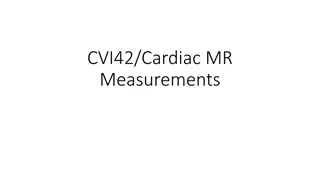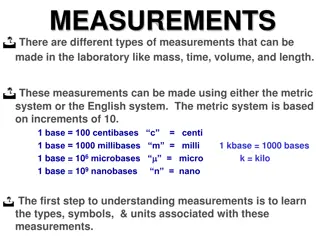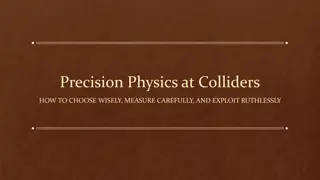Understanding Units and Measurements in Physics
Physics is the study of nature and its phenomena, involving various physical quantities like mass, length, time, area, and volume. These quantities can be fundamental or derived, with units selected as standards for measurement. The System International (SI) units offer advantages like coherence, rationality, absence of gravitational units, and applicability across all branches of physics. The dimensions of physical quantities are represented by powers of fundamental units, leading to dimensional formulas and equations that describe the units required for each quantity.
Download Presentation

Please find below an Image/Link to download the presentation.
The content on the website is provided AS IS for your information and personal use only. It may not be sold, licensed, or shared on other websites without obtaining consent from the author. Download presentation by click this link. If you encounter any issues during the download, it is possible that the publisher has removed the file from their server.
E N D
Presentation Transcript
Chapter 1 Units and Measurements
Physics: Derived from the Greek word Fu which means nature. Physics is a branch of science which deals with nature and natural phenomena. Physics Quantity: any quantity that can be measured. e.g. Mass, Length, Time, Area, Volume etc. Types of physical quantity: (1) Fundamental Quantity (2) Derived Quantity
Fundamental Quantity: The quantity which is independent of other physical quantity. e.g. Mass, Length, Time etc. these are the basic quantities. Derived Quantity: The quantity which can be derived from the fundamental quantities. E.g. Velocity, area, volume etc. Unit: A standard of measurement chosen for a physical quantity. Types of units: (1) Fundamental Units and (2) Derived Units
(1) Fundamental Units: Units used for the measurement of fundamental physical quantities like mass, length, time etc. (2) Derived Units: Units used for the measurement of derived physical quantities like velocity, area, volume etc. System of units (A set of fundamental and derived units) Types of System of units: (1) F.P.S. System (2) C.G.S. System (3) M.K.S. System (4) S.I. System
Advantages of SI Units: It is (1) Coherent system (derived units obtained from fundamental units without introducing any numerical factor.) (2) Rational system (only one unit is used for similar type of physical quantities) (3) Absolute system (no gravitational units used) (4) Metric system (5) Used to represent all branches of physics.
Dimensions of physical quantities: These are the powers to which the fundamental units of mass, length and time are to be raised to represent a derived unit of the physical quantity. e.g. dimensions for mass, length, time are [M],[L],[T] respectively. Dimensional formula: An expression showing how and which of the fundamental units are required to represent the units of a physical quantity. E.g. dimensional formula for area and velocity are [M0L2T0] and [M0L1T-1] respectively. Dimensional equation: The equation obtained by equating a physical quantity to its dimensional formula. E.g. area[A]= [M0L2T0] , volume[V]= [M0L3T0]
Table for dimensional formulae S.No Physical Quantity Physical Formula Dimensional Formula SI Unit [M0L1T-1] 1 Speed =Distance/Time m/s [M0L1T-1] 2 Velocity =Displacement/Time m/s [M0L1T-2] m/s2 3 Acceleration =Velocity/Time [M1L1T-2] Kg m/s2OR Newton(N) 4 Force = Mass Acceleration [M1L-3T0] Kg/m3 5 Density =Mass/Volume [M1L-1T-2] Kgm-1s-2 6 Pressure =Force/Area [M1L2T-2] Kgm-2s-2 7 Work =Force Displacement Contd..
S.No Physical Quantity Physical Formula Dimensional Formula SI Unit =(1/2)mv2 [M1 L2 T-2] Kgm2s-2 8 Kinetic energy [M1 L2 T-2] Kgm2s-2 9 Potential energy =mgh [M0 L0 T0] 10 Plane Angle( ) =Arc length/Radius No unit [M1 L1 T-1] Kgm1s-1 11 Impulse =Force Time [M1 L-1 T-2] Kgm-1s-2 12 Stress =Force/Area [M0 L0 T0] 13 Strain =Change in length/Original length No unit [M1 L1 T-1] Kgm1s-1 14 Momentum =Mass velocity
Principle of homogeneity of dimensions It states that the dimensions of all the terms on both sides of a dimension equation must be same. Thus we can say that a physical formula is dimensionally correct if the dimensions of both sides of its equation are same.
Applications of principle of homogeneity Checking the correctness of a given physical equation and Conversion of one system of units to another system
Calculate the dimensional formula of energy from the equation E = 1/2 mv2 . Sol. Dimensionally, E = mass (velocity)2 . Since 2 1 is a number and has no dimension. or, [E] = M (L/ T) 2 = ML2T 2
To Convert Units Of A Physical Quantity From One System Of Units To Another : It is based on the fact that, Numerical value(n) unit(u) = constant So on changing unit, numerical value will also gets changed. If n1 and n2 are the numerical values of a given physical quantity and u1 and u2 are the units respectively in two different systems of units, then n1 u1 = n2 u2 ?2 = ?1[?1 ?2]c ?2]a [?1 ?2]b [?1
Convert a force of 1N into dynes. Dimension of force[F]= [M1 L1 T-2] M.K.S System M1=1kg L1=1m T1=1s n1=1 ?2= ?1 [?1 ?2= 1 [1?? or ?2= 105 Thus,1N = 105 dynes M2=1g L2=1cm T2=1sec n2=? C.G.S System ?2]a [?1 1?]1 [1? ?2]b [?1 1??]1 [1? ?2]c 1?]-2 or ?2= 1 [1000? 1?]1 [100?? 1??]1 [1? 1?]-2

























